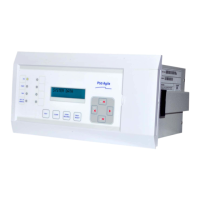event or maintenance record. The LED will flash until the alarms have been accepted (read).
Press the VIEW RECORD function key and it will change to ON. When the alarms have been
cleared, press the CLEAR key and the LED will switch OFF.
Programmable dual colour LED
2.1.4 RS 485 Port
The RS485 port is provided at the rear of relay (near to terminal block) for permanent SCADA
connectivity. The separate 5 Pin connector is used to avoid accidental connection of power wiring to
communication input. The RS485 port can be used to download Settings, Fault data, Live Event and
Disturbance Records.
2.1.5 USB Port
The USB port is situated on the front panel in the bottom right hand corner, and can be accessed by
opening the flap on the front of the relay. This port is used to communicate with a locally connected
PC.
It has three main purposes:
• Transferring settings information to/from the PC from/to the device.
• Downloading firmware updates.
• Downloading relay data for analysis.
The port is intended for temporary connection during testing, installation and commissioning. It is not
intended to be used for permanent SCADA communications.
You can connect the unit to a PC with a USB cable up to 15 m in length.
The USB port includes a USB full-speed function controller, USB transceiver, oscillator, EEPROM, and
synchronous serial data bus (UART). No other external USB components are required.
For configuration/setting the appropriate ‘config port’ has to be selected from the SYSTEM DATA
menu.

